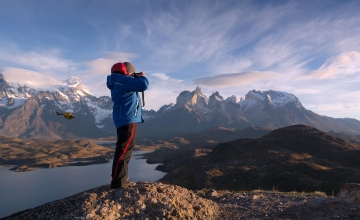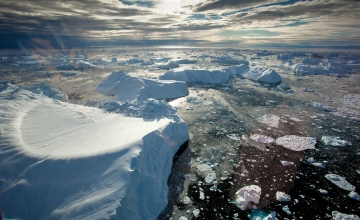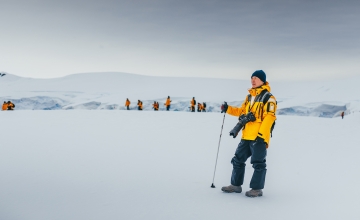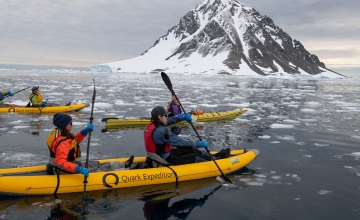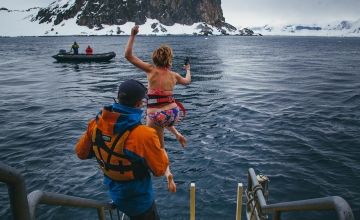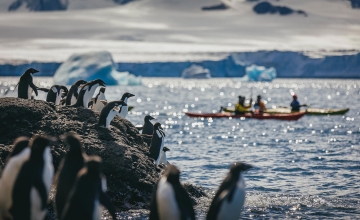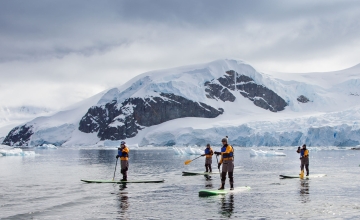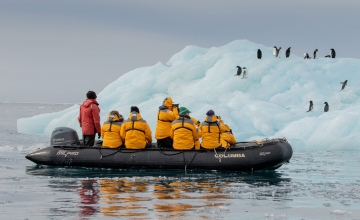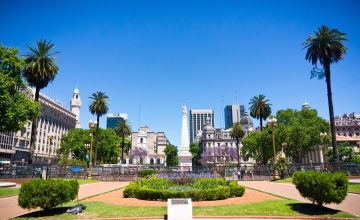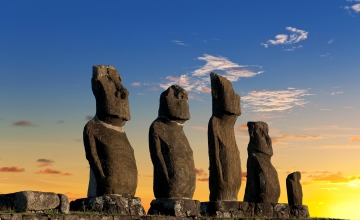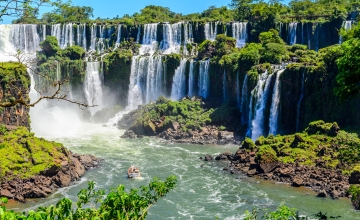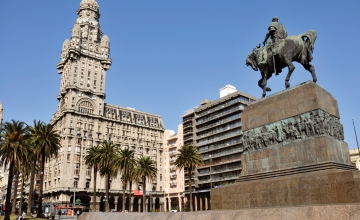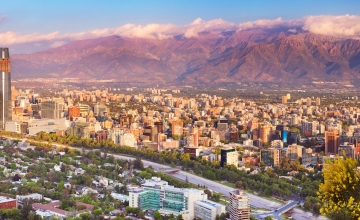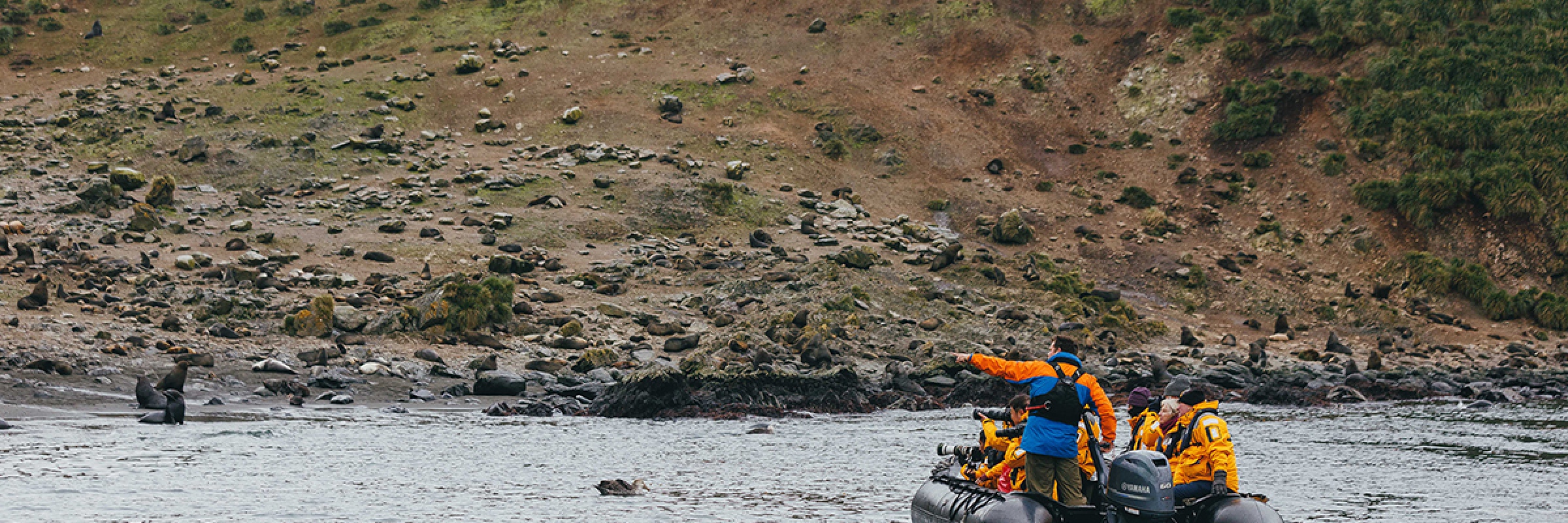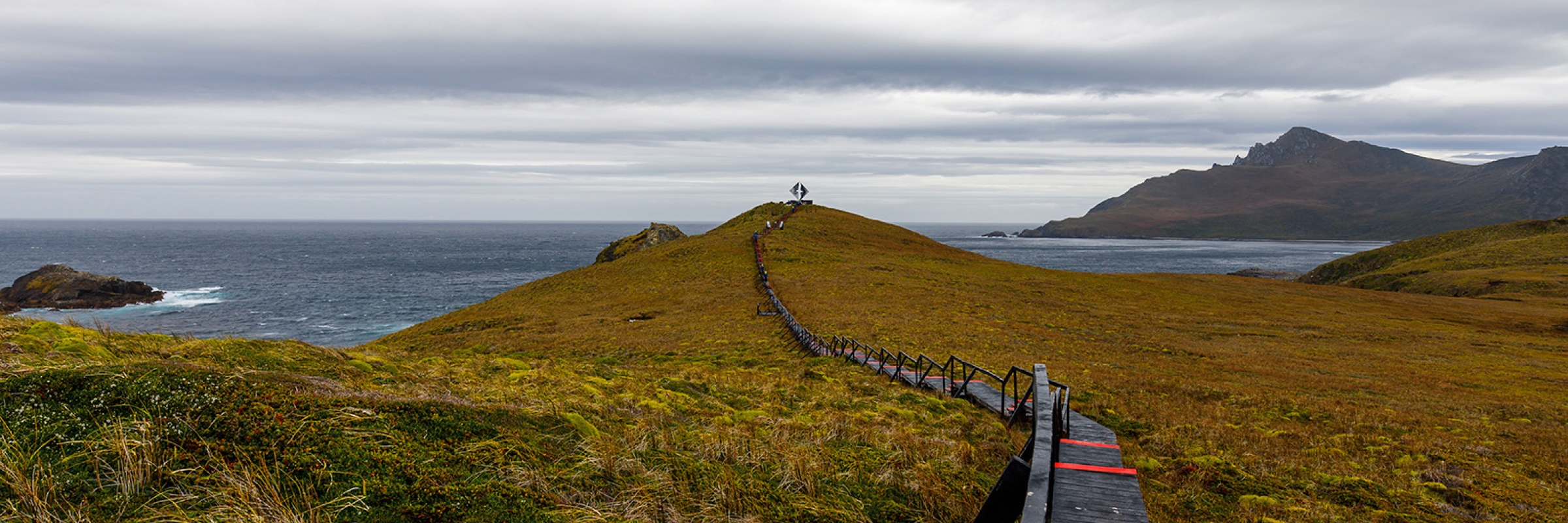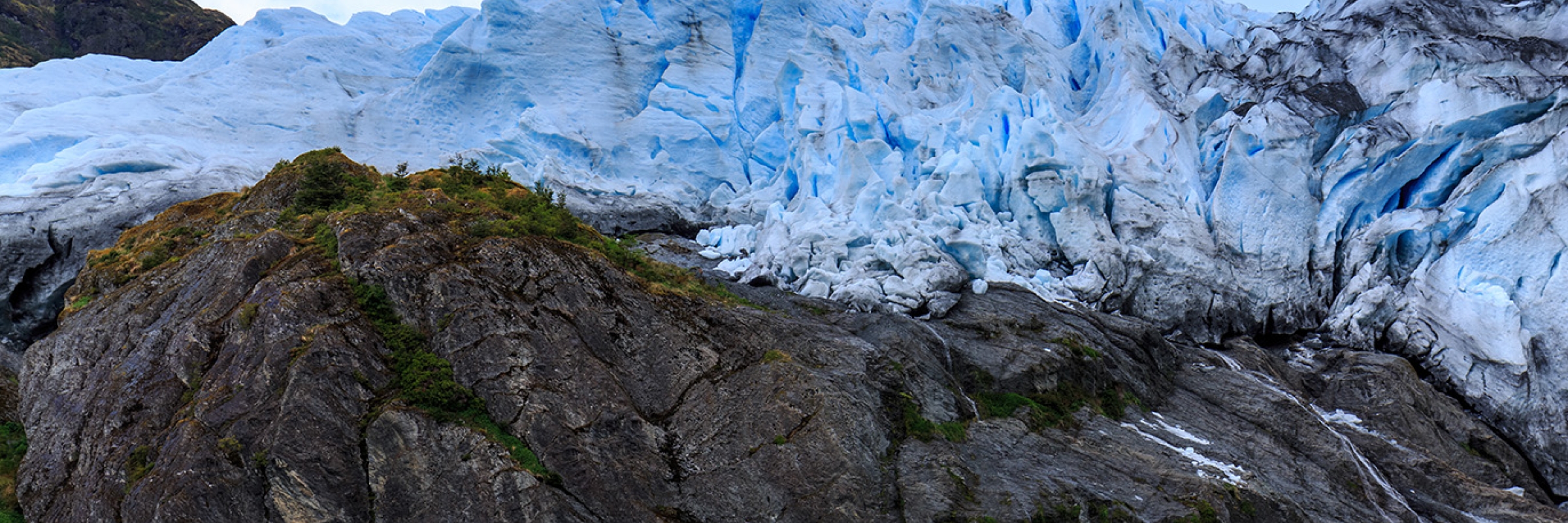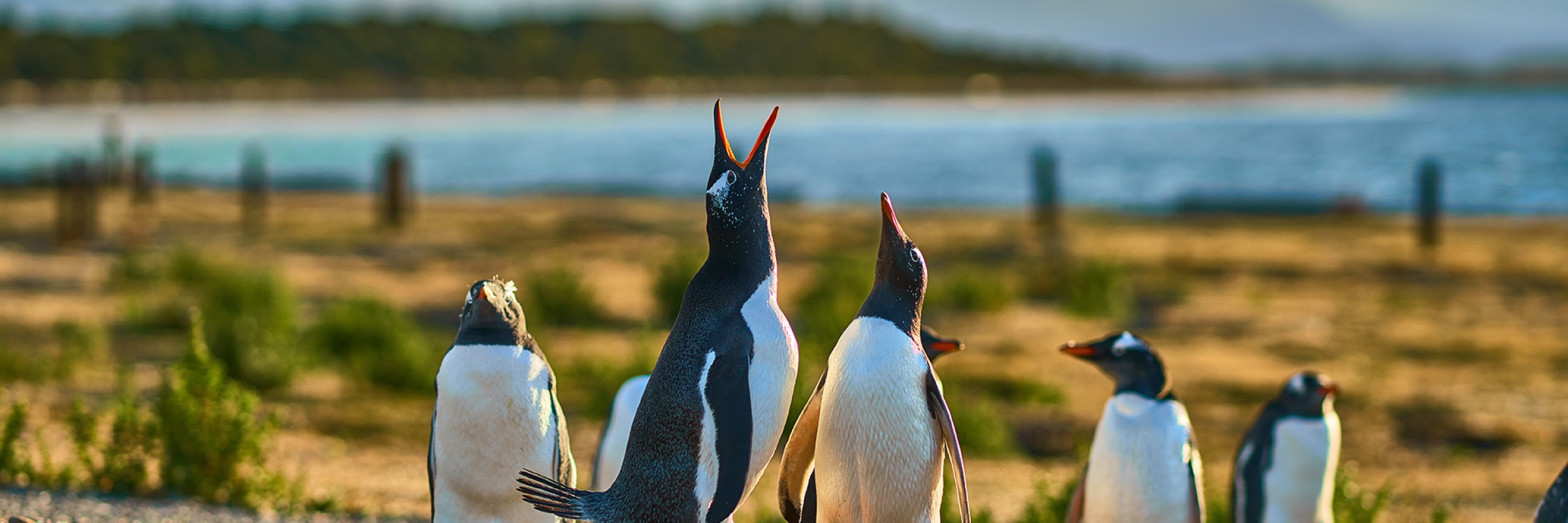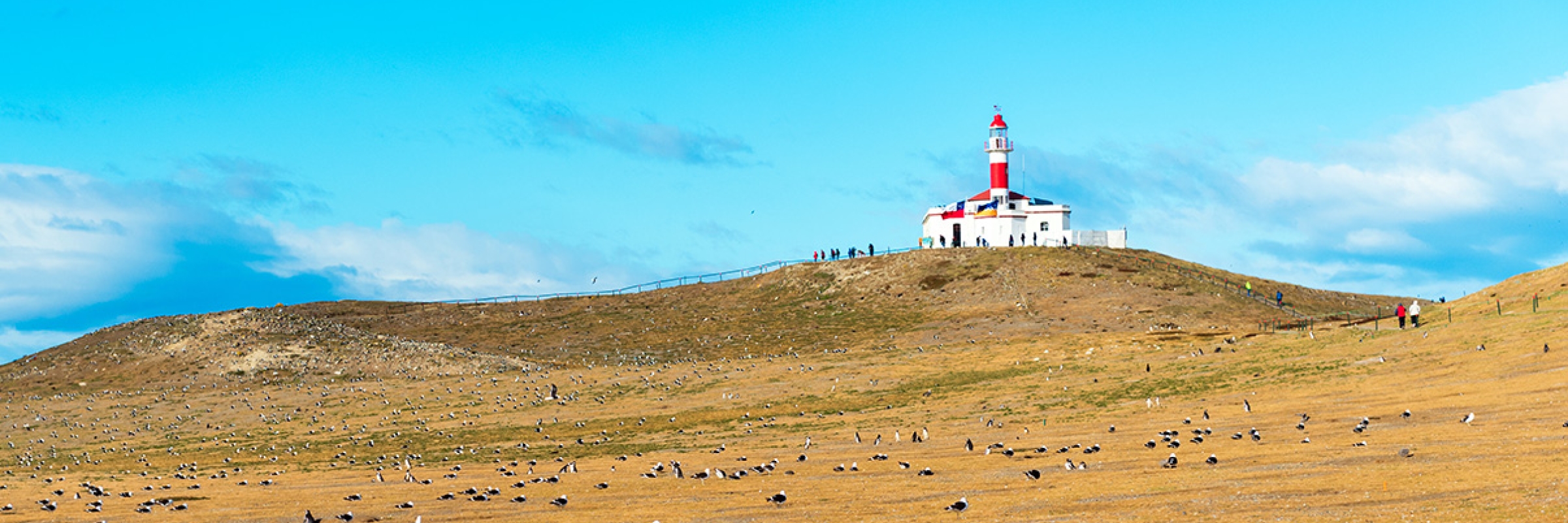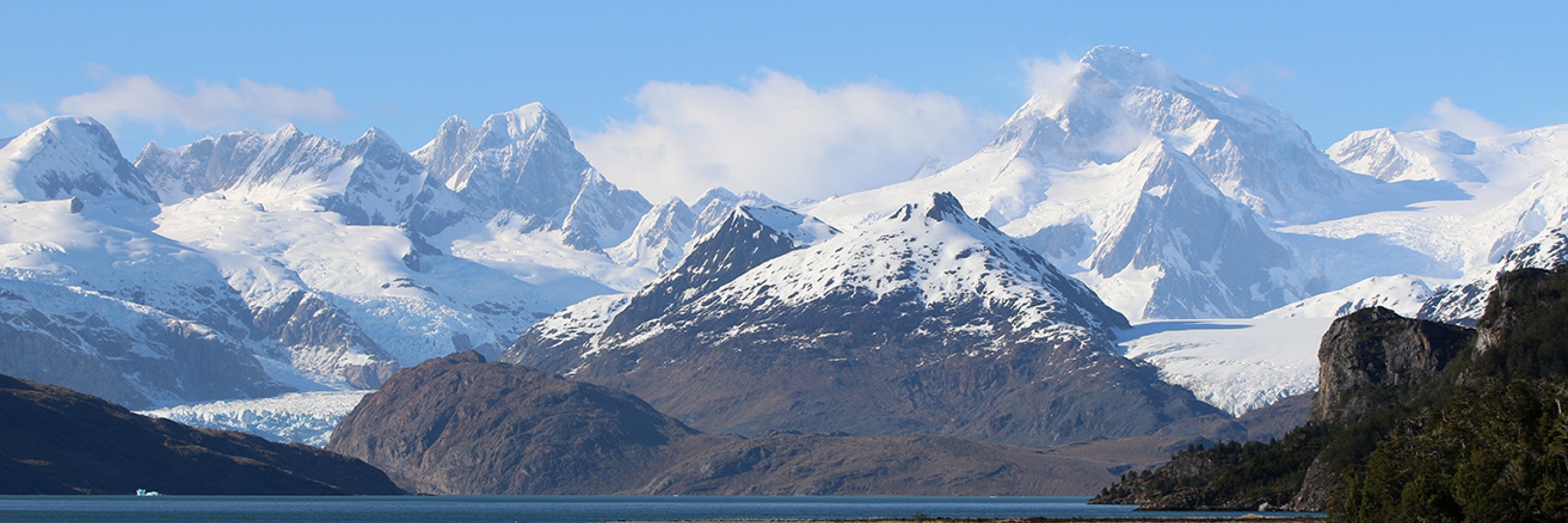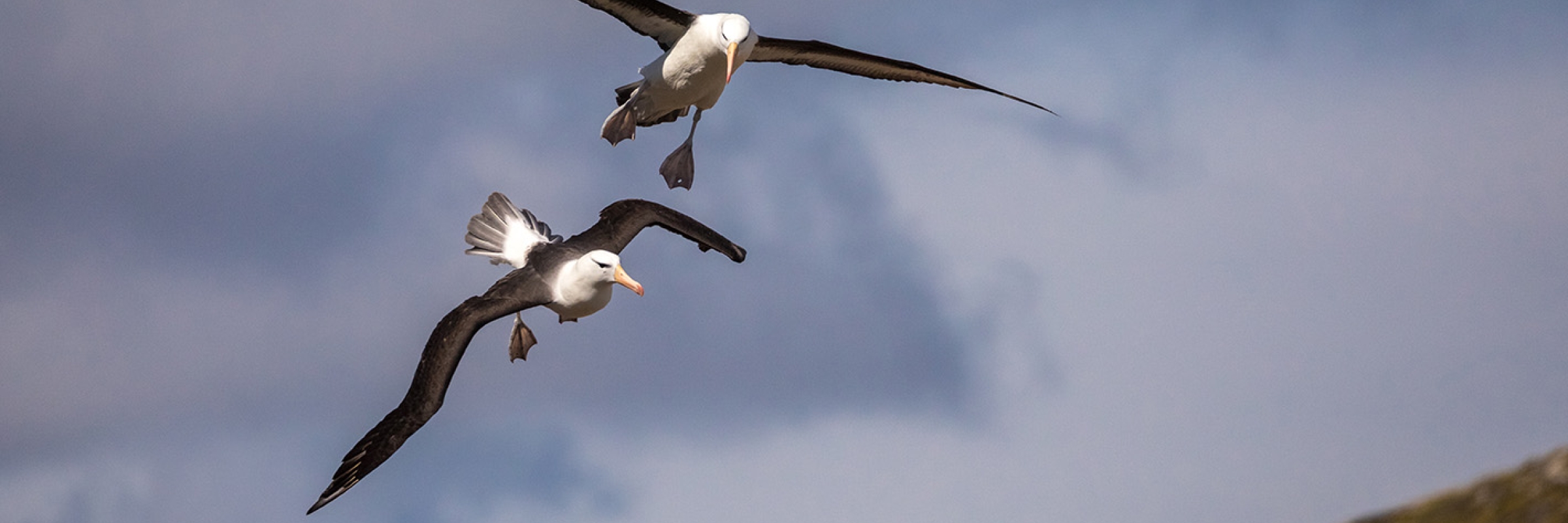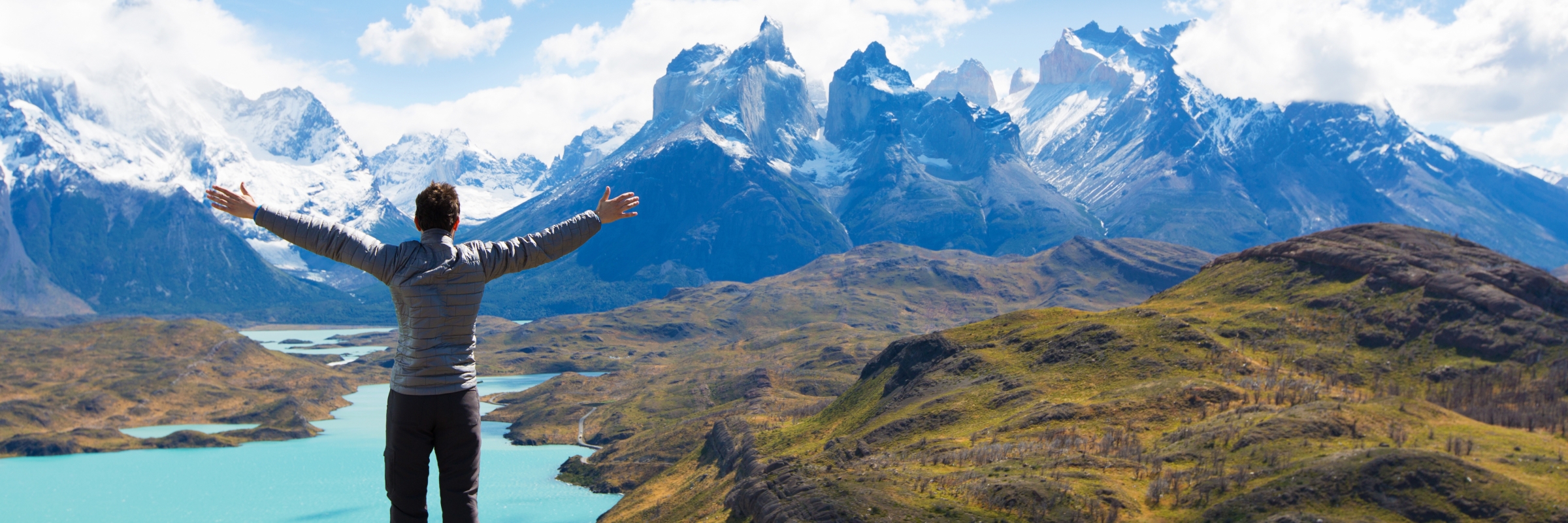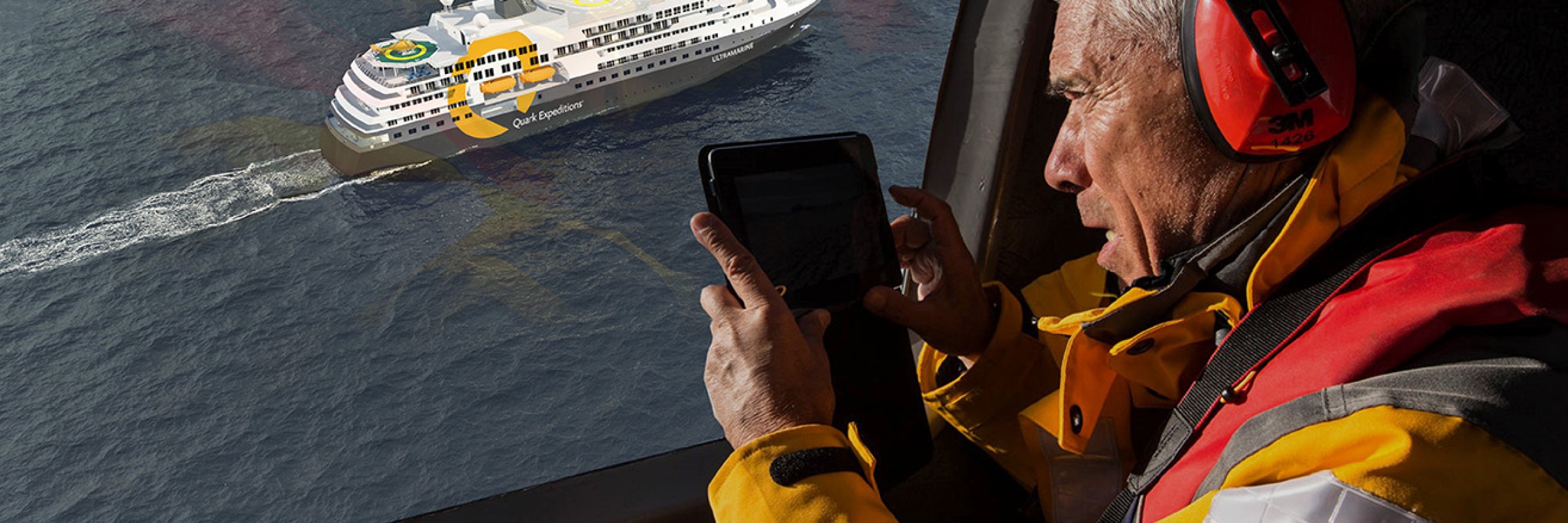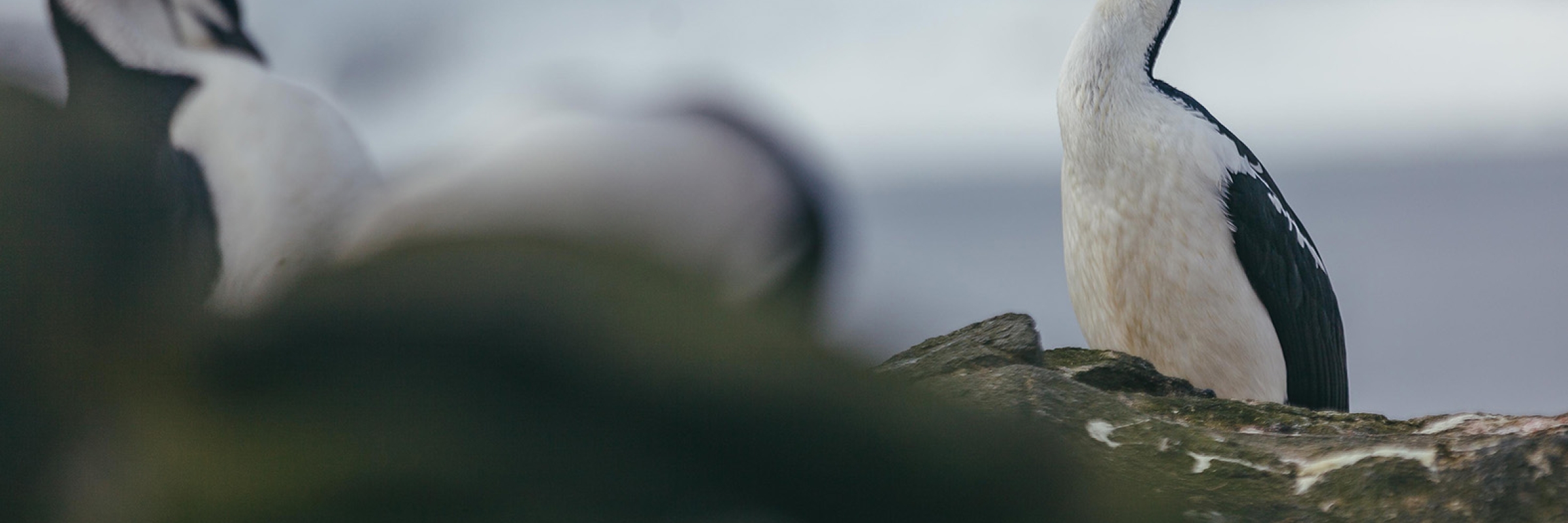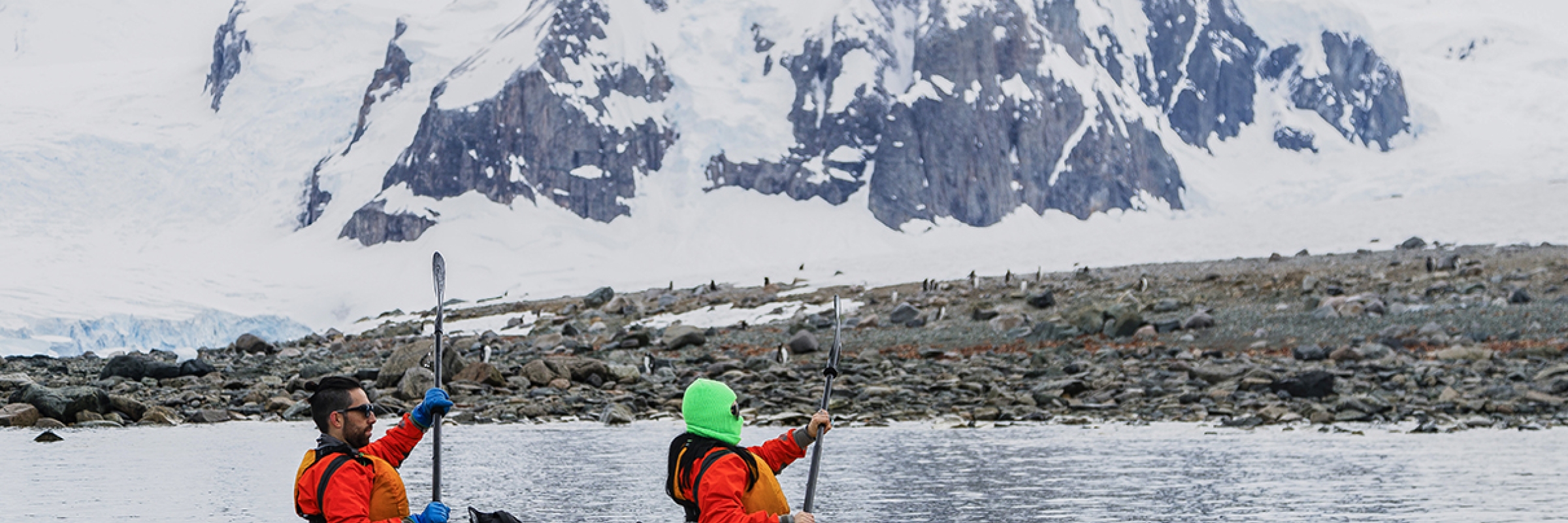You may arrive in Buenos Aires at any time during Day 1 of your itinerary. Upon arriving in this splendid city, known for its architecture and rich European heritage, you will independently transfer to your group hotel (pre-expedition hotel night included in mandatory transfer package).
Essential Patagonia: Chilean Fjords and Torres del Paine
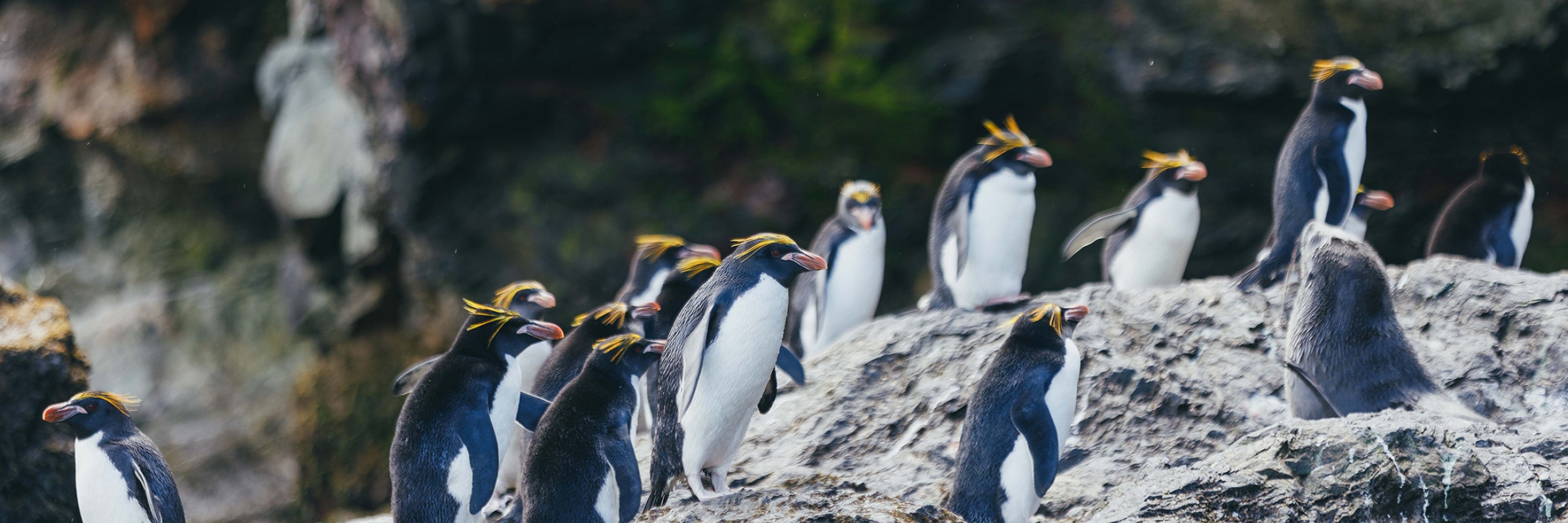
Retrace Charles Darwin’s epic voyage to the ‘edge of the world’ on our Essential Patagonia: Chilean Fjords and Torres del Paine expedition, a comprehensive journey into Chile’s spectacular network of fjords and channels. Helicopter flightseeing and Zodiac cruises along this enchanting stretch of coastline provide awe-inspiring perspectives of some of the most remote and picturesque landscapes on Earth. From Magellanic penguin colonies and other seabirds to South American sea lions and southern elephant seals, the fascinating array of wildlife is as abundant as the majestic blue-toned tidewater glaciers. Join us in this enchanting wonderland and experience all the natural splendors of southern Patagonia.
By coming aboard for this special journey, you will also be among the first guests to experience our pioneering new vessel, Ultramarine. This purpose-built vessel is designed to extend the boundaries of exploration and offer an unmatched experience, including a flightseeing tour you’ll never forget and a range of adventure options more extensive than any other ship in its class. We’re excited to host you on your unforgettable adventure! Please feel free to reach out to our team of Polar Travel Advisers, who are happy to answer your questions and provide assistance at any time.
- Encounter iconic wildlife, such as Magellanic penguins, sea lions and seabirds
- Experience some of the world’s most remote glacial and fjord systems, including Glacier Alley
- Retrace Darwin’s route through the Beagle Channel and learn about the storied history of southern Chile
- Cruise in a Zodiac for a unique perspective of glaciers, fjords and channels
- Enjoy helicopter flightseeing from Ultramarine for a unique perspective of the landscape
行程
Day 1 — Arrive in Buenos Aires, Argentina
Day 2 — Fly to Ushuaia and Embark
After an early breakfast at the hotel, the group will transfer to the airport and board our private charter flight to Ushuaia, Argentina.
Upon arrival, you will be transferred from the airport to a central downtown location to have some time on your own to explore this quaint port town before making your way to the pier.
After a late afternoon embarkation, you will sail along the historic Beagle Channel, which transects the Tierra del Fuego archipelago in the extreme south of South America.
Day 3 — Cape Horn
As we begin our exploration of Chile’s southern extent, expect a new adventure every day. Though each expedition will be different, depending on the weather, we aim to start our journey to the “edge of the earth” with a visit to historic Cape Horn (Cabo de Hornos). At the southernmost point of the Tierra del Fuego (“Land of Fire”) archipelago, this steep, rocky headland on Hornos Island marks the northern boundary of the famous Drake Passage, where the Atlantic and Pacific Oceans meet. From the 1700s to the early 1900s, prior to the opening of the Panama Canal, this cape was part of a major global trade route.
If sea and weather conditions allow, you may go ashore for a hike out to the lighthouse, the tiny Stella Maris (“Star of the Sea”) Chapel, and the albatross shaped monument honoring the many mariners who lost their lives attempting to “round the Horn.” Atop the windswept promontory, pause for a moment to take in the panoramic view and to enjoy the peaceful solitude that can only be found at one of the most southern stretches of land in the world. You can even have your passport stamped by the family operating the lighthouse!
Day 4 — Diego Ramirez Islands
Your ship will then continue cruising farther south, to the Diego Ramírez Islands, the most southern point of South America and one of the least explored places on the planet. This small archipelago was actually thought to be the southernmost land mass in the world when it was discovered in 1619 by the Spanish Garcia de Nodal expedition. Named after the expedition’s cosmographer, the archipelago held this distinction for 156 years, until Capt. James Cook’s discovery of the South Sandwich Islands in 1775. Weather permitting, depending on conditions, we may choose to Zodaic cruise or ship cruise cruise around these tussock- grasscovered islands to admire the abundant birdlife. A designated Important Bird Area, and part of the Diego Ramirez Islands and Drake Passage Marine Park, the archipelago is home to tens of thousands of breeding seabirds, and an exceptional place for birdwatching. Binoculars in hand, birders will marvel at the sight of nesting black-browed albatross and grey-headed albatross. These islands are the southernmost mollymawk albatross breeding ground in the world. Sightings of dolphins, South American fur seals, and rockhopper, macaroni and Magellanic penguins are also possible here.
Day 5 — Pia and Garibaldi Glaciers, Glacier Alley
As our ship sails north toward the southern edge of Tierra del Fuego, stimulating presentations by your Expedition Team will enrich your knowledge of the glacial systems, geology, environment, wildlife and storied history of the region as you retrace Charles Darwin’s historic journey through the Beagle Channel, a 150-mile (240 km) strait separating Tierra del Fuego’s main island from several smaller islands. Named after Captain Robert FitzRoy’s famous ship on which Charles Darwin was a young naturalist, the channel presents plenty of photo ops to capture seabirds hovering overhead and dramatic vistas of jagged peaked mountains and massive tidewater glaciers. Rugged and untouched, this magnificent landscape is as starkly beautiful as it was when Darwin first laid eyes on it in 1833. What he experienced in this region would later help him form his earthshaking theory on evolution by natural selection.
Glacier Alley (as it’s nicknamed) is one of the most spectacular ship passages in Tierra del Fuego. To honour the European countries that first explored the region, the glaciers have taken their names—España (Oblicuo), Romanche, Alemania (Roncagli), Francia, Italia, and Holland Glaciers.
Situated within the protected boundary of Alberto de Agostini National Park, both Pia and Garibaldi Glaciers sit at the head of picturesque ice-choked fjords that offer jaw-dropping views. Located within the Cordillera Darwin (Darwin Mountain Range), the impressive Pia Glacier extends from the soaring mountaintops down into the sea. A short hike to a lookout point provides superb vistas of the glacier and mountains.
Surrounded by pristine sub-Antarctic forests, Garibaldi Glacier flows from a separate mountain, providing equally exceptional views, with the Darwin Mountains rising dramatically out of the fjord. We can explore this area by Zodiac, including a beautiful glacial waterfall nearby.
As we navigate the fjords, your Expedition Team will keep watch for Andean condors, massive birds rivaled in wingspan by only the wandering Albatross.
Day 6 — Dainelli (Aguila) Glacier
Located at the end of a tranquil lagoon surrounded by lush sub-Antarctic forests in Agostini Sound, Dainelli Glacier (sometimes called Aguila—Spanish for “Eagle” Glacier) is a unique sight, as it appears to flow over rolling hills rather than mountains. Cruising aboard a Zodiac toward the blue-tinged wall of ice, conditions permitting, you will be humbled by the wonder of nature’s power. We hope to venture ashore for an easy hike along the beach to get a more intensive look at the glacier and surrounding mountains.
Day 7 — Cruising the Chilean Fjords
Continuing north, we’ll navigate through a remote network of coastal fjords and channels, including time spent venturing out into the Pacific Ocean. Your Expedition Team will prepare you for the adventures that await, helping you further understand the glacial systems, as well as the flora and fauna that can be found in this part of Chile. Take a moment, as we glide past soaring snow-capped peaks, to contemplate the mariners of long ago who traveled these same sheltered passageways, and were rewarded with the same wondrous sights.
Days 8 and 9 — Puerto Natales and Torres Del Paine National Park
Sailing the turquoise waters of the extraordinary stretch of coastline leading to the small port of Puerto Natales, we’ll meander through a mesmerizing maze of deep, windswept fjords, narrow channels and isolated bays, with an eye toward the rugged landscape, unique wildlife and impressive glaciers that tumble from the towering mountains into the icy waters below, along with the imperial and king cormorants, South American terns, blacknecked swans and southern wigeons (Chiloé wigeons) that frequent the fjords.
Torres del Paine National Park is one of the most stunning wilderness areas in South America, and Puerto Natales is the gateway. This enormous park is a UNESCO Biosphere Reserve, so designated for both its natural wonders and ancient human history and named for the three granite peaks that tower above the glacier-fed lakes. Enjoy a full day of hiking tailored to your preferred activity level and stopping at lookouts in the park, followed by a traditional Patagonian barbecue in the afternoon.
Taking our expedition onto dry land for another full day, we will also visit a working Patagonian estancia (“ranch”), founded in 1891 by Scottish immigrants. Here you will learn about Patagonian sheep farming in a historic pastoral setting. Inhabiting the surrounding grasslands are the ostrich-like rhea, and guanacos, a wild relative of the domestic llama. Complete your cultural experience with a lunch of barbecued lamb al palo (“on a stick”) and return to the ship in the early evening.
Day 10 — Canal de las Montañas
Cruising the calm, crystal-clear waters of the Canal de las Montañas (“Channel” or “Fjord of the Mountains”) will leave you breathless. You’ll be awed by the amazing series of waterfalls cascading down between the jagged peaks that rise up sharply on either side of the narrow, 41-mile (66 km) long channel dotted with glaciers, five of which spill dramatically into the water. Here, impressive ice fields glisten, and steeply sloped glaciers exceed elevations over 8,235 feet (2,510 meters). The channel also provides an ideal place to put our Zodiacs in the water for more detailed exploring or going ashore for a hike to scenic viewpoints. If you’re feeling more adventurous, perhaps you’ll treat yourself to an optional kayaking excursion (extra cost), an exceptional opportunity to experience the channel from a special perspective.
Day 11 — Tuckers Islets
A series of small islands and rocky outcrops in Almirantazgo Sound (“Admiralty Sound”), a fjord off the Strait of Magellan, Tuckers Islets is a superb location for viewing penguins. Though landing here is prohibited to protect the fragile nesting habitat, a Zodiac excursion will take you very near a pebble beach to view a colony of 4,000-plus breeding Magellanic penguins, conditions permitting. Named for Portuguese explorer Ferdinand Magellan, whose crew sighted the charming creatures in 1520 during the first circumnavigation of the globe, the species is native to the region, and the sight of them in their burrows, lounging on the beach or waddling in and out of the water, is one you won’t forget. If we’re fortunate, we may also see Chilean skuas, Magellanic cormorants (rock shags), imperial cormorants (king shags), oystercatchers, kelp geese, or even dolphins.
Day 12 — Ainsworth Bay and Islote Albatros
Continuing our exploration of Almirantazgo Sound, we plan to explore ashore at Ainsworth Bay, one of the most picturesque and pristine places in Patagonia. Surrounded by untouched sub-Antarctic forest, this isolated bay is a protected area within the border of Alberto de Agostini National Park. It hosts abundant birdlife, so you’ll want to keep your eyes peeled as we cruise in the Zodiacs. Hiking options will be available for all fitness levels, affording panoramic views of Marinelli Glacier, Marinelli Fjord and the surrounding Darwin mountain range.
In 2003, a small breeding colony of black browed albatross was documented on Islote Albatros (“Albatross Islet”), located in Admiralty Sound. Normally albatross are seabirds, nesting and feeding in coastal waters and open ocean; this the first record of a colony of this species in inland waters, feeding mainly in fjords and channels.
Day 13 — Bahia Brookes
Another excellent spot for glacier exploring in Almirantazgo Sound is Bahia Brookes (Brookes Bay), where, conditions permitting, we’ll go ashore by Zodiac. The bay offers ample chances for closer views of a number of waterfalls and glaciers, including the calving North Brookes Glacier, set against the breathtaking backdrop of the towering Darwin mountain range. Amid the serene silence of this icy wonderland, the only sound you may hear is the powerful roar of ice breaking off and crashing into the frigid waters below. This is also a great location for viewing ice fall deposits, which form reconstituted glaciers, and kame (silt and sediment deposits).
Day 14 — Marta Island
In the middle of the Strait of Magellan, Marta Island (Isla Marta) is home to abundant birdlife and more than one thousand Patagonian (South American) sea lions. To protect the wildlife, shore landings are not possible here, but we do plan to circumnavigate the island, providing numerous opportunities to observe and photograph the colony from a short distance, in the comfort of a Zodiac. Called lobos marinos (“sea wolves”) by local Chileans, these giant pinnipeds—males can weigh over 700 pounds/320 kg—form quite a noisy group as each sea lion vies for a choice spot of coastline. As you cruise by, sightings of imperial cormorants, skuas, southern gulls, Antarctic pigeons—and if we’re lucky, dolphins—are also possible.
Day 15 — Disembark in Punta Arenas and Fly to Santiago, Chile
After an adventurous two weeks of exploration, you’ll say goodbye to your Expedition Team and disembark fin Punta Arenas, to be transferred.

Day 1 — Arrive in Buenos Aires, Argentina
You may arrive in Buenos Aires at any time during Day 1 of your itinerary. Upon arriving in this splendid city, known for its architecture and rich European heritage, you will independently transfer to your group hotel (pre-expedition hotel night included in mandatory transfer package).
Day 2 — Fly to Ushuaia and Embark
After an early breakfast at the hotel, the group will transfer to the airport and board our private charter flight to Ushuaia, Argentina.
Upon arrival, you will be transferred from the airport to a central downtown location to have some time on your own to explore this quaint port town before making your way to the pier.
After a late afternoon embarkation, you will sail along the historic Beagle Channel, which transects the Tierra del Fuego archipelago in the extreme south of South America.
Day 3 — Cape Horn
As we begin our exploration of Chile’s southern extent, expect a new adventure every day. Though each expedition will be different, depending on the weather, we aim to start our journey to the “edge of the earth” with a visit to historic Cape Horn (Cabo de Hornos). At the southernmost point of the Tierra del Fuego (“Land of Fire”) archipelago, this steep, rocky headland on Hornos Island marks the northern boundary of the famous Drake Passage, where the Atlantic and Pacific Oceans meet. From the 1700s to the early 1900s, prior to the opening of the Panama Canal, this cape was part of a major global trade route.
If sea and weather conditions allow, you may go ashore for a hike out to the lighthouse, the tiny Stella Maris (“Star of the Sea”) Chapel, and the albatross shaped monument honoring the many mariners who lost their lives attempting to “round the Horn.” Atop the windswept promontory, pause for a moment to take in the panoramic view and to enjoy the peaceful solitude that can only be found at one of the most southern stretches of land in the world. You can even have your passport stamped by the family operating the lighthouse!
Day 4 — Diego Ramirez Islands
Your ship will then continue cruising farther south, to the Diego Ramírez Islands, the most southern point of South America and one of the least explored places on the planet. This small archipelago was actually thought to be the southernmost land mass in the world when it was discovered in 1619 by the Spanish Garcia de Nodal expedition. Named after the expedition’s cosmographer, the archipelago held this distinction for 156 years, until Capt. James Cook’s discovery of the South Sandwich Islands in 1775. Weather permitting, depending on conditions, we may choose to Zodaic cruise or ship cruise cruise around these tussock- grasscovered islands to admire the abundant birdlife. A designated Important Bird Area, and part of the Diego Ramirez Islands and Drake Passage Marine Park, the archipelago is home to tens of thousands of breeding seabirds, and an exceptional place for birdwatching. Binoculars in hand, birders will marvel at the sight of nesting black-browed albatross and grey-headed albatross. These islands are the southernmost mollymawk albatross breeding ground in the world. Sightings of dolphins, South American fur seals, and rockhopper, macaroni and Magellanic penguins are also possible here.
Day 5 — Pia and Garibaldi Glaciers, Glacier Alley
As our ship sails north toward the southern edge of Tierra del Fuego, stimulating presentations by your Expedition Team will enrich your knowledge of the glacial systems, geology, environment, wildlife and storied history of the region as you retrace Charles Darwin’s historic journey through the Beagle Channel, a 150-mile (240 km) strait separating Tierra del Fuego’s main island from several smaller islands. Named after Captain Robert FitzRoy’s famous ship on which Charles Darwin was a young naturalist, the channel presents plenty of photo ops to capture seabirds hovering overhead and dramatic vistas of jagged peaked mountains and massive tidewater glaciers. Rugged and untouched, this magnificent landscape is as starkly beautiful as it was when Darwin first laid eyes on it in 1833. What he experienced in this region would later help him form his earthshaking theory on evolution by natural selection.
Glacier Alley (as it’s nicknamed) is one of the most spectacular ship passages in Tierra del Fuego. To honour the European countries that first explored the region, the glaciers have taken their names—España (Oblicuo), Romanche, Alemania (Roncagli), Francia, Italia, and Holland Glaciers.
Situated within the protected boundary of Alberto de Agostini National Park, both Pia and Garibaldi Glaciers sit at the head of picturesque ice-choked fjords that offer jaw-dropping views. Located within the Cordillera Darwin (Darwin Mountain Range), the impressive Pia Glacier extends from the soaring mountaintops down into the sea. A short hike to a lookout point provides superb vistas of the glacier and mountains.
Surrounded by pristine sub-Antarctic forests, Garibaldi Glacier flows from a separate mountain, providing equally exceptional views, with the Darwin Mountains rising dramatically out of the fjord. We can explore this area by Zodiac, including a beautiful glacial waterfall nearby.
As we navigate the fjords, your Expedition Team will keep watch for Andean condors, massive birds rivaled in wingspan by only the wandering Albatross.
Day 6 — Dainelli (Aguila) Glacier
Located at the end of a tranquil lagoon surrounded by lush sub-Antarctic forests in Agostini Sound, Dainelli Glacier (sometimes called Aguila—Spanish for “Eagle” Glacier) is a unique sight, as it appears to flow over rolling hills rather than mountains. Cruising aboard a Zodiac toward the blue-tinged wall of ice, conditions permitting, you will be humbled by the wonder of nature’s power. We hope to venture ashore for an easy hike along the beach to get a more intensive look at the glacier and surrounding mountains.
Day 7 — Cruising the Chilean Fjords
Continuing north, we’ll navigate through a remote network of coastal fjords and channels, including time spent venturing out into the Pacific Ocean. Your Expedition Team will prepare you for the adventures that await, helping you further understand the glacial systems, as well as the flora and fauna that can be found in this part of Chile. Take a moment, as we glide past soaring snow-capped peaks, to contemplate the mariners of long ago who traveled these same sheltered passageways, and were rewarded with the same wondrous sights.
Days 8 and 9 — Puerto Natales and Torres Del Paine National Park
Sailing the turquoise waters of the extraordinary stretch of coastline leading to the small port of Puerto Natales, we’ll meander through a mesmerizing maze of deep, windswept fjords, narrow channels and isolated bays, with an eye toward the rugged landscape, unique wildlife and impressive glaciers that tumble from the towering mountains into the icy waters below, along with the imperial and king cormorants, South American terns, blacknecked swans and southern wigeons (Chiloé wigeons) that frequent the fjords.
Torres del Paine National Park is one of the most stunning wilderness areas in South America, and Puerto Natales is the gateway. This enormous park is a UNESCO Biosphere Reserve, so designated for both its natural wonders and ancient human history and named for the three granite peaks that tower above the glacier-fed lakes. Enjoy a full day of hiking tailored to your preferred activity level and stopping at lookouts in the park, followed by a traditional Patagonian barbecue in the afternoon.
Taking our expedition onto dry land for another full day, we will also visit a working Patagonian estancia (“ranch”), founded in 1891 by Scottish immigrants. Here you will learn about Patagonian sheep farming in a historic pastoral setting. Inhabiting the surrounding grasslands are the ostrich-like rhea, and guanacos, a wild relative of the domestic llama. Complete your cultural experience with a lunch of barbecued lamb al palo (“on a stick”) and return to the ship in the early evening.
Day 10 — Canal de las Montañas
Cruising the calm, crystal-clear waters of the Canal de las Montañas (“Channel” or “Fjord of the Mountains”) will leave you breathless. You’ll be awed by the amazing series of waterfalls cascading down between the jagged peaks that rise up sharply on either side of the narrow, 41-mile (66 km) long channel dotted with glaciers, five of which spill dramatically into the water. Here, impressive ice fields glisten, and steeply sloped glaciers exceed elevations over 8,235 feet (2,510 meters). The channel also provides an ideal place to put our Zodiacs in the water for more detailed exploring or going ashore for a hike to scenic viewpoints. If you’re feeling more adventurous, perhaps you’ll treat yourself to an optional kayaking excursion (extra cost), an exceptional opportunity to experience the channel from a special perspective.
Day 11 — Tuckers Islets
A series of small islands and rocky outcrops in Almirantazgo Sound (“Admiralty Sound”), a fjord off the Strait of Magellan, Tuckers Islets is a superb location for viewing penguins. Though landing here is prohibited to protect the fragile nesting habitat, a Zodiac excursion will take you very near a pebble beach to view a colony of 4,000-plus breeding Magellanic penguins, conditions permitting. Named for Portuguese explorer Ferdinand Magellan, whose crew sighted the charming creatures in 1520 during the first circumnavigation of the globe, the species is native to the region, and the sight of them in their burrows, lounging on the beach or waddling in and out of the water, is one you won’t forget. If we’re fortunate, we may also see Chilean skuas, Magellanic cormorants (rock shags), imperial cormorants (king shags), oystercatchers, kelp geese, or even dolphins.
Day 12 — Ainsworth Bay and Islote Albatros
Continuing our exploration of Almirantazgo Sound, we plan to explore ashore at Ainsworth Bay, one of the most picturesque and pristine places in Patagonia. Surrounded by untouched sub-Antarctic forest, this isolated bay is a protected area within the border of Alberto de Agostini National Park. It hosts abundant birdlife, so you’ll want to keep your eyes peeled as we cruise in the Zodiacs. Hiking options will be available for all fitness levels, affording panoramic views of Marinelli Glacier, Marinelli Fjord and the surrounding Darwin mountain range.
In 2003, a small breeding colony of black browed albatross was documented on Islote Albatros (“Albatross Islet”), located in Admiralty Sound. Normally albatross are seabirds, nesting and feeding in coastal waters and open ocean; this the first record of a colony of this species in inland waters, feeding mainly in fjords and channels.
Day 13 — Bahia Brookes
Another excellent spot for glacier exploring in Almirantazgo Sound is Bahia Brookes (Brookes Bay), where, conditions permitting, we’ll go ashore by Zodiac. The bay offers ample chances for closer views of a number of waterfalls and glaciers, including the calving North Brookes Glacier, set against the breathtaking backdrop of the towering Darwin mountain range. Amid the serene silence of this icy wonderland, the only sound you may hear is the powerful roar of ice breaking off and crashing into the frigid waters below. This is also a great location for viewing ice fall deposits, which form reconstituted glaciers, and kame (silt and sediment deposits).
Day 14 — Marta Island
In the middle of the Strait of Magellan, Marta Island (Isla Marta) is home to abundant birdlife and more than one thousand Patagonian (South American) sea lions. To protect the wildlife, shore landings are not possible here, but we do plan to circumnavigate the island, providing numerous opportunities to observe and photograph the colony from a short distance, in the comfort of a Zodiac. Called lobos marinos (“sea wolves”) by local Chileans, these giant pinnipeds—males can weigh over 700 pounds/320 kg—form quite a noisy group as each sea lion vies for a choice spot of coastline. As you cruise by, sightings of imperial cormorants, skuas, southern gulls, Antarctic pigeons—and if we’re lucky, dolphins—are also possible.
Day 15 — Disembark in Punta Arenas and Fly to Santiago, Chile
After an adventurous two weeks of exploration, you’ll say goodbye to your Expedition Team and disembark fin Punta Arenas, to be transferred.

